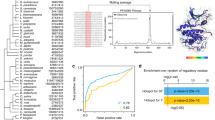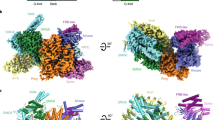Abstract
Sky1p is the only member of the SR protein kinase (SRPK) family in Saccharomyces cerevisiae. SRPKs are constitutively active kinases that display remarkable substrate specificity and have been implicated in RNA processing. Here we present the three-dimensional structure of a fully active truncated Sky1p. Analysis of the structure and structure-based functional studies reveal that the C-terminal tail, an unusual Glu residue located in the P+1 loop, and a unique mechanism for the positioning of helix αC act together to render Sky1p constitutively active. We have modeled a substrate peptide bound to Sky1p. The modeled complex combined with mutagenesis studies illustrate the molecular basis for substrate recognition by this kinase and suggest a mechanism by which SRPKs catalyze a sequential phosphorylation reaction of the consecutive RS dipeptide repeats characteristic of mammalian SRPK substrates.
This is a preview of subscription content, access via your institution
Access options
Subscribe to this journal
Receive 12 print issues and online access
$189.00 per year
only $15.75 per issue
Buy this article
- Purchase on Springer Link
- Instant access to full article PDF
Prices may be subject to local taxes which are calculated during checkout






Similar content being viewed by others
Accession codes
References
Cao, W. & Garcia-Blanco, M.A. A serine/arginine-rich domain in the human U1 70k protein is necessary and sufficient for ASF/SF2 binding. J. Biol. Chem. 273, 20629–20635 (1998).
Xiao, S.H. & Manley, J.L. Phosphorylation of the ASF/SF2 RS domain affects both protein-protein and protein-RNA interactions and is necessary for splicing. Genes Dev. 11, 334–344 (1997).
Gui, J.-F., Tronchere, H., Chandler, S.D. & Fu, X.-D. Purification and characterization of a kinase specific for the serine- and arginine-rich pre-mRNA splicing factors. Proc. Natl. Acad. Sci. USA 91, 10824–10828. (1994).
Siebel, C.W., Feng, L., Guthrie, C. & Fu, X.D. Conservation in budding yeast of a kinase specific for SR splicing factors. Proc. Natl. Acad. Sci. USA 96, 5440–5445 (1999).
Kadowaki, T. et al. Isolation and characterization of Saccharomyces cerevisiae mRNA transport-defective (mtr) mutants. J. Cell Biol. 126, 649–659 (1994).
Lee, M.S., Henry, M. & Silver, P.A. A protein that shuttles between the nucleus and the cytoplasm is an important mediator of RNA export. Genes Dev. 10, 1233–1246 (1996).
Yun, C.Y. & Fu, X.-D. Conserved SR protein kinase is involved in regulated nuclear import and its action is counteracted by arginine methylation in S. cerevisiae. J. Cell Biol. 150, 707–717 (2000).
Colwill, K. et al. SRPK1 and Clk/Sty protein kinases show distinct substrate specificities for serine/arginine-rich splicing factors. J. Biol. Chem. 271, 24569–24575 (1996).
Wang, H.Y. et al. SRPK2: a differentially expressed SR protein-specific kinase involved in mediating the interaction and localization of pre-mRNA splicing factors in mammalian cells. J. Cell Biol. 140, 737–750 (1998).
Taylor, S.S. & Radzio-Andzelm, E. Three protein kinase structures define a common motif. Structure 2, 345–355 (1994).
Canagarajah, B.J., Khokhlatchev, A., Cobb, M.H. & Goldsmith, E.J. Activation mechanism of the MAP kinase ERK2 by dual phosphorylation. Cell 90, 859–869 (1997).
Xie, X. et al. Crystal structure of JNK3: a kinase implicated in neuronal apoptosis. Structure 6, 983–991 (1998).
Bellon, S., Fitzgibbon, M.J., Fox, T., Hsiao, H.-M. & Wilson, K.P. The structure of phosphorylated P38gamma is monomeric and reveals a conserved activation-loop conformation. Structure 7, 1057–1065 (1999).
Zheng, J. et al. 2.2 Å refined crystal structure of the catalytic subunit of cAMP-dependent protein kinase complexed with MnATP and a peptide inhibitor. Acta Crystallogr. D 49, 362–365 (1993).
Jeffrey, P.D. et al. Mechanism of CDK activation revealed by the structure of a cyclinA-CDK2 complex. Nature 376, 313–320 (1995).
Radzio-Andzelm, E., Lew, J. & Taylor, S. Bound to activate: conformational consequences of cyclin binding to CDK2. Structure 3, 1135–1141 (1995).
Taylor, S.S. et al. Catalytic subunit of cyclic AMP-dependent protein kinase: structure and dynamics of the active site cleft. Pharmacol. Ther. 82, 133–141 (1999).
Johnson, L.N., Noble, M.E.M. & Owen, D.J. Active and inactive protein kinases: structural basis for regulation. Cell 85, 149–158 (1996).
Johnson, L.N., Lowe, E.D., Noble, M.E.M. & Owen, D.J. The structural basis for substrate recognition and control by protein kinases. FEBS Lett. 430, 1–11 (1998).
Niefind, K., Guerra, B., Pinna, L.A., Issinger, O.-G. & Schomburg, D. Crystal structure of the catalytic subunit of protein kinase CK2 from Zea mays at 2.1 angstrom resolution. EMBO J. 17, 2451–2462 (1998).
Brown, N.R., Nobel, E.M., Endicott, J.A. & Johnson, L.N. The structural basis for specificity of substrate and recruitment peptides for cyclin-dependent kinases. Nature Cell Biol. 1, 438–443 (1999).
De Bondt, H.L. et al. Crystal structure of cyclin-dependent kinase 2. Nature 363, 595–602 (1993).
Wilson, K.P. et al. Crystal structure of p38 mitogen-activated protein kinase. J. Biol. Chem. 271, 27696–27700 (1996).
Wang, Z. et al. The structure of mitogen-activated protein kinase p38 at 2.1-Å resolution. Proc. Natl. Acad. Sci. USA 94, 2327–2332 (1997).
Zhang, J., Zhang, F., Ebert, D., Cobb, M.H. & Goldsmith, E.J. Activity of the MAP kinase ERK2 is controlled by a flexible surface loop. Structure 3, 299–307 (1995).
Roach, P.J. Multisite and hierarchical protein phosphorylation. J. Biol. Chem. 266, 14139–14142 (1991).
Stojdl, D.F. & Bell, J.C. SR protein kinases: the splice of life. Biochem. Cell Biol. 77, 293–298 (1999).
Otwinowski, Z. & Minor, W. Processing of X-ray diffraction data collected in oscillation mode. Methods Enzymol. 276, 307–326 (1997).
Terwilliger, T.C. & Berendzen, J. Automated MAD and MIR structure solution. Acta Crystallogr. D 55, 849–861 (1999).
LaFortelle, E.d. & Bricogne, G. Maximun-likelihood heavy-atom parameter refinement in the MIR and MAD methods. Methods Enzymol. 276, 472–494 (1997).
Jones, T.A. & Kjeldgaard, M. Improved methods for building protein models in electron density maps and the location of errors in these models. Acta Crystallogr. A 47, 110–119 (1991).
Brunger, A.T. et al. Crystallography and NMR system: a new software suite for macromolecular structure determination. Acta Crystallogr. D 54, 905–921 (1998).
Laskowski, R.A., MacArthur, M.W., Moss, D.S. & Thorton, J.M. PROCHECK: a program to check the stereochemical quality of protein structures. J. Appl. Crystallogr. 26, 283–291 (1993).
Phelps, C.B., Sengchanthalangsy, L.L., Huxford, T. & Ghosh, G. Mechanism of IκBα binding to NFκB dimers. J. Biol. Chem. 275, 29840–29846 (2000).
Kraulis, P.J. MOLSCRIPT: a program to produce both detailed and schematic plots of protein structures. J. Appl. Crystallogr. 24, 946–950 (1991).
Hubbard, S.R., Crystal structure of the activated insulin receptor tyrosine kinase in complex with peptide substrate and ATP analog. EMBO J. 16, 5572–5581 (1997).
Meritt, E.A. & Murphy, M.E.P. Raster3d version 2.0 — a program for photorealistic molecular graphics. Acta Crystallogr. D 50, 869–873 (1994).
Madura, J.D. et al. Electrostatics and diffusion of molecules in solution: simulations with the University of Houston Brownian Dynamics program. Comput. Phys. Commun. 91, 57–95 (1995).
Nicholls, A., Sharp, K.A. & Honig, B. Protein folding and association — insights from the interfacial and thermodynamic properties of hydrocarbons. Proteins 11, 281–296 (1991).
Acknowledgements
We wish to thank T. Huxford and the other members of the Ghosh lab for comments on the manuscript and N. Nguyen for his technical assistance at the UCSD X-ray source. B.N. is supported by a fellowship from the Molecular Biophysics Training Program. C.Y. is a National Cancer Institute graduate trainee for Cancer Cell Biology. X.-D.F. is a Leukemia and Lymphoma Scholar; G.G. is an Alfred P. Sloan fellow.
Author information
Authors and Affiliations
Corresponding author
Rights and permissions
About this article
Cite this article
Nolen, B., Yun, C., Wong, C. et al. The structure of Sky1p reveals a novel mechanism for constitutive activity. Nat Struct Mol Biol 8, 176–183 (2001). https://doi.org/10.1038/84178
Received:
Accepted:
Issue Date:
DOI: https://doi.org/10.1038/84178
This article is cited by
-
The prion-like protein kinase Sky1 is required for efficient stress granule disassembly
Nature Communications (2019)
-
Serine arginine protein kinase 1 (SRPK1): a moonlighting protein with theranostic ability in cancer prevention
Molecular Biology Reports (2019)
-
Regulation of splicing by SR proteins and SR protein-specific kinases
Chromosoma (2013)
-
Identification of a nuclear localization motif in the serine/arginine protein kinase PSRPK of physarum polycephalum
BMC Biochemistry (2009)
-
Srpk2
AfCS-Nature Molecule Pages (2005)



